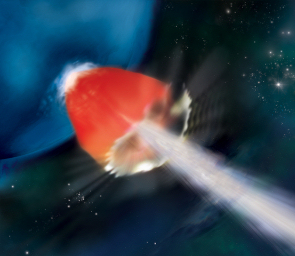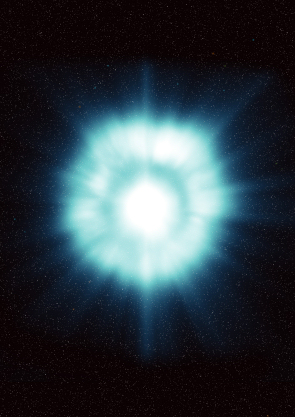Bizarre nearby blast mimics Universe's most ancient stars
11 July 2014
ESA's XMM-Newton observatory has helped to uncover how the Universe's first stars ended their lives in giant explosions.
 |
| Artist's impression of an exploding blue supergiant star. Credit: NASA/Swift/A. Simonnet, Sonoma State Univ. |
Astronomers studied the gamma-ray burst GRB130925A – a flash of very energetic radiation streaming from a star in a distant galaxy – using space- and ground-based observatories.
They found the culprit producing the burst to be a massive star, known as a blue supergiant. These huge stars are quite rare in the relatively nearby Universe where GRB130925A is located, but are thought to have been very common in the early Universe, with almost all of the very first stars having evolved into them over the course of their short lives.
But unlike other blue supergiants we see nearby, GRB130925A's progenitor star contained very little in the way of elements heavier than hydrogen and helium. The same was true for the first stars to form in the Universe, making GRB130925A a remarkable analogue for similar explosions that occurred just a few hundred million years after the Big Bang.
"There have been several theoretical studies predicting what a gamma-ray burst produced by a primordial star would look like," says Luigi Piro of the Istituto Astrofisica e Planetologia Spaziali in Rome, Italy, and lead author of a new paper appearing in The Astrophysical Journal Letters. "With our discovery, we've shown that these predictions are likely to be correct."
Astronomers believe that primordial stars were very large, perhaps several hundred times the mass of the Sun. This large bulk then fuelled ultralong gamma-ray bursts lasting several thousand seconds, up to a hundred times the length of a 'normal' gamma-ray burst.
Indeed, GRB130925A had a very long duration of around 20 000 seconds, but it also exhibited additional peculiar features not previously spotted in a gamma-ray burst: a hot cocoon of gas emitting X-ray radiation and a strangely thin wind.
Both of these phenomena allowed astronomers to implicate a blue supergiant as the stellar progenitor. Crucially, they give information on the proportion of the star composed of elements other than hydrogen and helium, elements that astronomers group together under the term 'metals'.
 |
| Artist's impression of a Gamma-ray burst. Credit: ESA, illustration by ESA/ECF |
After the Big Bang, the Universe was dominated by hydrogen and helium and therefore the first stars that formed were very metal-poor. However, these first stars made heavier elements via nuclear fusion and scattered them throughout space as they evolved and exploded.
This process continued as each new generation of stars formed, and thus stars in the nearby Universe are comparatively metal-rich.
Finding GRB130925A's progenitor to be a metal-poor blue supergiant is significant, offering the chance to explore an analogue of one of those very first stars at close quarters. Dr Piro and his colleagues speculate that it might have formed out of a pocket of primordial gas that somehow survived unaltered for billions of years.
"The quest to understand the first stars that formed in the Universe some 13 billion years ago is one of the great challenges of modern astrophysics," notes Dr Piro.
"Detecting one of these stars directly is beyond the reach of any present or future observatory due to the immense distances involved.
"But it should ultimately be possible to find them as they explode at the end of their lives, producing powerful flashes of radiation."
As a nearby counterpart, however, GRB130925A has offered astronomers the opportunity to gain some insight into these first stars today.
"XMM-Newton's space-based location and sensitive X-ray instruments were key to observing the later stages of this blast, several months after it first appeared," says ESA's XMM-Newton project scientist Norbert Schartel.
"At these times, the fingerprints of the progenitor star were clearer, but the source itself was so dim that only XMM-Newton's instruments were sensitive enough to take the detailed measurements needed to characterise the explosion."
A number of space- and ground-based missions were involved in the discovery and characterisation of GRB130925A. Alongside the XMM-Newton observations, the astronomers involved in this study also used X-ray data gathered at different times with NASA's Swift Burst Alert Telescope, and radio data from the CSIRO's Australia Telescope Compact Array.
"Combining these observations was crucial to get a full picture of this event," added Eleonora Troja of NASA's Goddard Space Flight Center in Maryland, USA, a co-author of the paper.
"This new understanding of GRB130925A means that we now have strong indications how a primordial explosion might look – and therefore what to search for in the distant Universe," says Dr Schartel.
The search will require powerful facilities. The NASA/ESA/CSA James Webb Space Telescope, an infrared successor to the Hubble Space Telescope due for launch in 2018, and ESA's planned Athena mission, a large X-ray observatory following on from XMM-Newton in 2028, will both have key roles to play.
Background Information
"A Hot Cocoon in the Ultralong GRB 130925A: Hints of a PopIII-like Progenitor in a Low Density Wind Environment" by L. Piro et al. is published in The Astrophysical Journal Letters.
GRB130925A triggered the Swift Burst Alert Telescope on 25 September 2013 at 04:11:24 GMT. Early gamma-ray emission was detected by Integral, and the burst was subsequently observed by the Fermi Gamma-Ray Burst Monitor, Konus-Wind, Swift's X-ray telescope, Chandra, the Gamma-Ray Burst Optical/Near-Infrared Detector, the Hubble Space Telescope and the CSIRO's Australia Telescope Compact Array. GRB130925A was located in a galaxy so far away that its light has been travelling for 3.9 billion years.
ESA's XMM-Newton was launched in December 1999. The largest scientific satellite to have been built in Europe, it is also one of the most sensitive X-ray observatories ever flown. More than 170 wafer-thin, cylindrical mirrors direct incoming radiation into three high-throughput X-ray telescopes. XMM-Newton's orbit takes it almost a third of the way to the Moon, allowing for long, uninterrupted views of celestial objects.
Contacts
Markus Bauer
ESA Science and Robotic Exploration Communication Officer
Tel: +31 71 565 6799
Mob: +31 61 594 3 954
Email: markus.bauer![]() esa.int
esa.int
Luigi Piro
Istituto Astrofisica e Planetologia Spaziali, INAF
Rome, Italy
Tel: +39 06 4993 4007
Email: Luigi.Piro![]() iaps.inaf.it
iaps.inaf.it
Eleonora Troja
NASA Goddard Space Flight Center
Tel: +1 301 286 0941
Email: Eleonora.Troja![]() nasa.gov
nasa.gov
Norbert Schartel
XMM-Newton Project Scientist
Tel: +34 91 8131 184
Email: Norbert.Schartel![]() sciops.esa.int
sciops.esa.int


